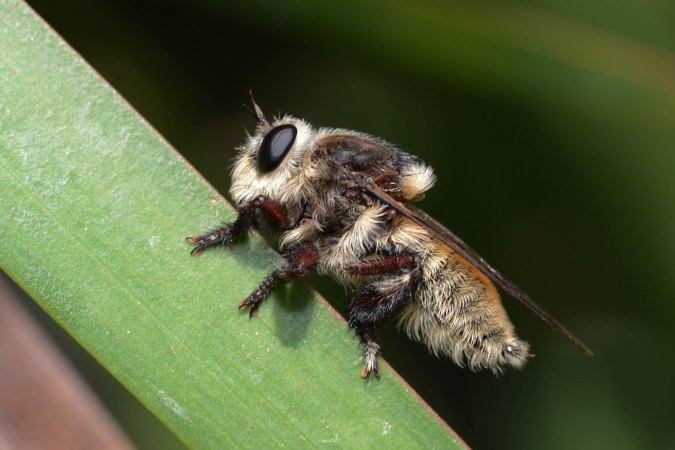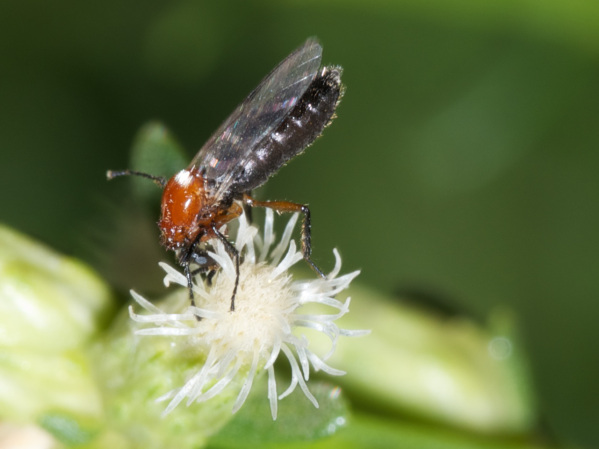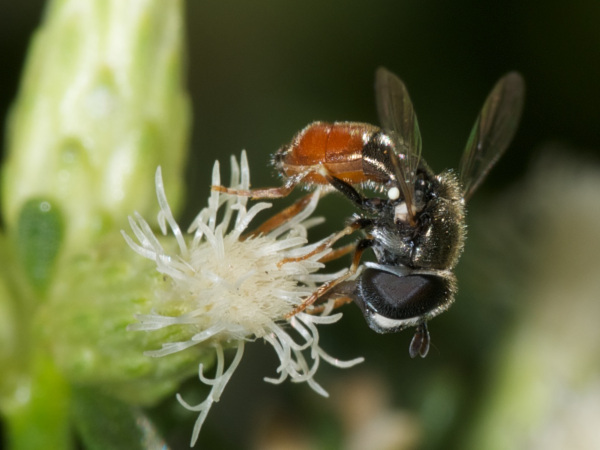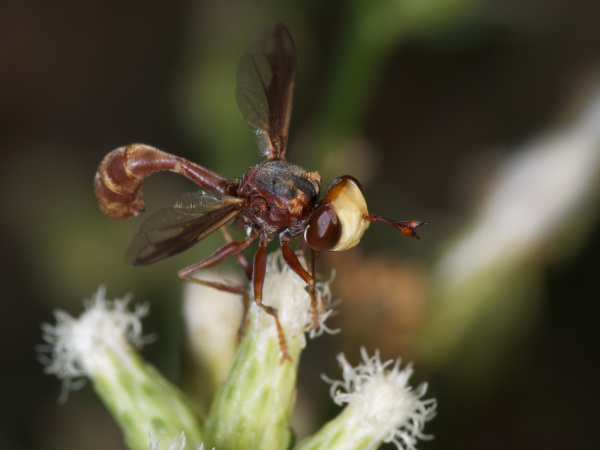 There is a voracious predator in our nature garden at the Natural History Museum of Los Angeles County; luckily it is only about an inch long. It is a “bumble bee robber fly” of the genus Mallophora. It is hanging out on the kangaroo paws in the garden on the east side of the building. It picks off wasps and bees, injects them with venom and digestive enzymes, and sucks them dry. As I said, we can all be thankful that it is only an inch long, but it is beautiful and fun to watch!
There is a voracious predator in our nature garden at the Natural History Museum of Los Angeles County; luckily it is only about an inch long. It is a “bumble bee robber fly” of the genus Mallophora. It is hanging out on the kangaroo paws in the garden on the east side of the building. It picks off wasps and bees, injects them with venom and digestive enzymes, and sucks them dry. As I said, we can all be thankful that it is only an inch long, but it is beautiful and fun to watch!
Tag Archives: gardening
Gardening for flies 4. Use Baccharis.
I recently witnessed and photographed an incredible assemblage of insects. They were on flowering female plants of Baccharis ‘Centennial’, a widely available hybrid of a plant commonly known around here as “coyote bush”. It was used extensively in what we call the 1913 Garden at the Natural History Museum of Los Angeles County, where I work.
For the last couple of weeks, the plants have been swarming with insects, including many Diptera. In fact, I was first alerted to the situation by Richard Hayden, our Head Gardener, who described a swarm of flies in the area. We went to check it out, and I had my first view of the seething mass of insects on and around the plants, apparently feeding on nectar.
The following photos are only a few of the flies on this swath of Baccharis in downtown L.A. I suggest using this plant in any insect-friendly landscape.
Gardening for flies 3 – adding filth
In my continued quest to attract subjects for my photography, I decided to try to attract the drone fly, Eristalis tenax, a relatively large flower fly that mimics honeybees. Their rat-tailed larvae are said to be found in extremely foul aquatic conditions, such as cesspools, and runoff from feedlots. Not wanting to deal with feces in attracting these flies, I decided to try just using plant material. I put in a few rotting peaches, some soil, and some mulch in a plastic container and filled about half full with water. I then let it sit for a month, keeping the water level up so that it didn’t dry out. A cautious sniff confirmed that I had replicated the high degree of foul stench that I was trying for. It was contained, however, in a small area, that didn’t affect the rest of the yard.
So far, no drone flies have been noted, but a different and equally interesting fly was attracted. This fly, commonly known as a “boatman fly” is a species classified in the family Platystomatidae. Its scientific name is Pogonortalis doclea, and like many denizens of the city, it is a non-native. Somehow it has arrived here from Australia and become naturalized to our city.
Its behavior is interesting: it constantly waives its wings, which are marked with distinctive patterns of black. This display is usually considered either a threat to other males, or a welcome to females. Whichever, these flies display all the time, as well as projecting their mouthparts in and out. Look at this video and you’ll see what I mean. Disgustingly, these flies feed on the foul water, and in you can see thousands of maggots writhing around it.
http://youtu.be/isH20jaD9gU
The filthy water also attracts other flies, including Megaselia scalaris, one of the most polyphagous (feeds on anything) of all the phorid flies. It is found around the world, having been successful at living wherever humans live.
I’ll keep my eye on the filth container, and see what else turns up. I still haven’t given up on the rat tailed maggots, which might show up next year when I increase the amount of filth.
Gardening for flies, part 2
Having had my garden for about three months now, I can say that there is always something interesting to see and photograph in it. Regular visitors include many flower flies, commonest of which is the little blood red flower fly, Paragus haemorrhous, followed by Allograpta obliqua, Syritta pipiens, and a Platycheirus species. During the sunny parts of the day, there are ALWAYS flower flies.
Another group of frequent visitors are bees. Mostly, however, they are not the common honeybee; instead, they are native bees that are much more welcome, in my opinion. Native bees do not sting people unless severely provoked, and they come in a variety of shapes and sizes from tiny little, almost gnat-sized bees to lumbering fuzzy bumblebees. They are generally faster moving than honeybees, and thus more difficult to photograph, but if you focus on a popular flower and wait, you can usually catch them eventually.
Finally, there are the occasional visitors, that show up to feed on specific type of pollen. Among them are a couple of types of beetles, including dermestid beetles (shown below) that are occasional household pests, and the wedge-shaped tumbling flower beetles of the family Mordellidae.
all photos are copyright B. Brown, 2011. all rights retained
Gardening for flies
Brian Brown’s instant flower fly garden
It probably doesn’t occur to many people to collect plants specifically to attract flies to their garden, but during my work on flower flies, I started getting more and more interested in photography again. I could go to the Arboretum, or somewhere else with many flowers in order to photograph interesting flies, but I wanted something closer to home. Also, I started thinking about what would be an optimal garden or collection of plants to attract flower flies. I needed to do some research.
Flower flies are generally considered a gardener’s friend. The larvae, or maggots, of the most common backyard species feed on aphids, scales, and other softbodied insects. By attacking the gardener’s worst enemies flower flies become a potent ally.
In order to make these allies more welcome in our backyards, it is necessary only to plant a few, low-cost flowers. These provide the nectar and pollen that flower flies need to fuel their flight and mature their eggs, respectively. Not just any flower will do, however. Flower flies appreciate flat flowers whose pollen is easily reached. They also have different requirements than honeybees, so planting a garden for flower flies will not attract swarms of stinging invaders. It will attract native bees, though, which provide a welcome addition to the flower fly parade.
I wanted to see which flowers would be best for attracting flower flies to my backyard, so I went to my local (Los Angeles area) nursery and just watched the activity in their displays. It quickly became apparent that flower flies were concentrating on just a few of the offered scores of plants available. Therefore I bought one plant or flat each of the flies favorites: Japanese Photinius, pink and purple cosmos, white “mini-margarite” daisies (Chrysanthemum paludosum), and yellow Argyranthemum. The total cost for my mini garden was $18. I brought them home, set them in the sun, and waited.
Within half an hour I had flower flies coming to them. Instant success! Since then, I have had a continual parade of flower flies, native bees, and other interesting insects to enjoy and photograph. I also added a couple more plants: sweet alyssum, which is another flower fly attractive plant I observed in the nursery, and bog sage, something I’d seen attracting many flies at the Arboretum. I put the whole garden in four plastic pots for more maneuverability.
This low-cost, minimal garden will bring a constant supply of colorful, beneficial insects to your yard, which will increase the number of predators attacking aphids and other pests, and boost your backyard biodiversity. It takes up so little space that it could even be put on a balcony or postage stamp lawn and still be successful. Of course, if you have more space, you can put out more than one of each plant, and you will probably attract even more interesting creatures.
Next posting: what has been attracted to my instant garden, and which plants are best.






